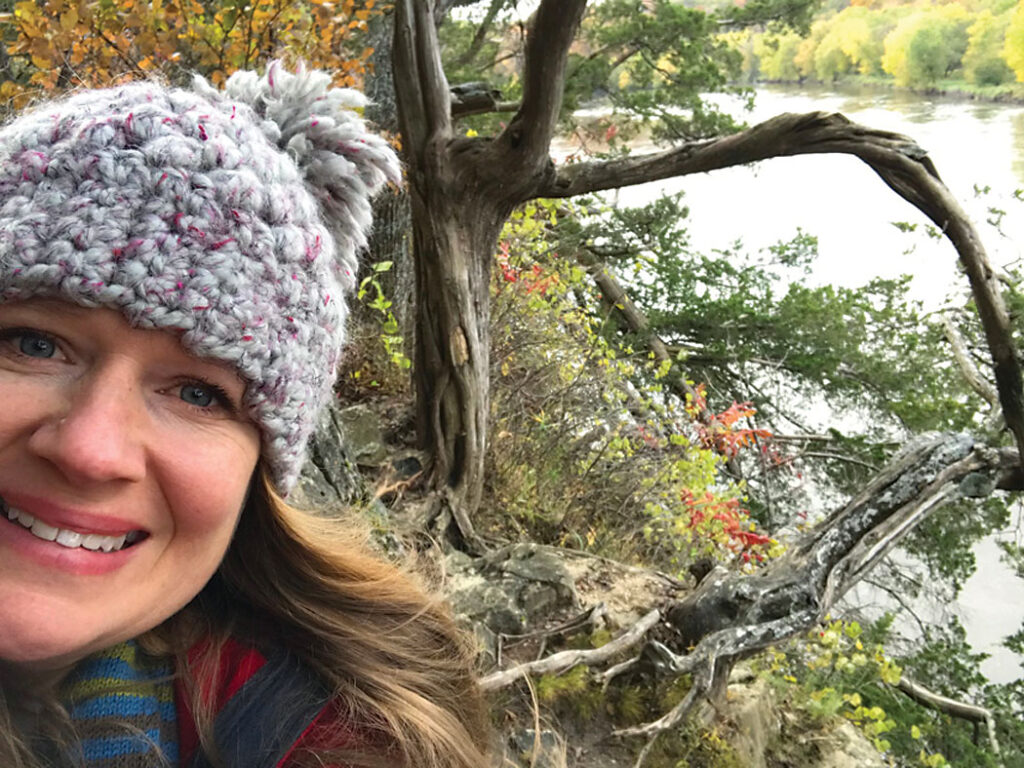
The answering machine picked up at Dad’s house. He was probably in the woodshop making calculations for his latest design—a plant stand, a birdhouse, or a pair of stilts for one of the grandkids.
“Hey, Pop, I don’t know what you’re doing this weekend, but you’re going to want to clear your schedule and drive to Palisades-Kepler State Park. I’m here on top of a bluff overlooking the Cedar River, the forest is literally glowing around me, and … you really need to see this. Come today. Or tomorrow. Bring your camera.”
Striking Gold at Palisades-Kepler
It was a brisk but bright late October day as I continued my quest for worthy “waterside walks,” and within a few minutes on Overlook Trail, I started wondering why I’d been the last to hear about this place. I’d still be ignorant of it if I hadn’t eavesdropped on a couple of pizza eaters at the Lincoln Wine Bar.
Once inside the park just off Highway 30 (four miles west of Mount Vernon), I drove as far east as I could along the river and hopped out at the first parking lot for a look-see. A zigzaggy path wound down amidst sparse trees, turning into a staircase that threaded itself right through a narrow stone arch and spilled out onto the Cedar River’s bank. What a grand introduction.
In front of me, a dam stretched wide across the water—its powerful rush imitating the roar of the ocean, a single fishing boat was braving the morning’s chill just beyond the tumbling waters, and rosy-gold bluffs rose up at my back. Looking west in the direction of my hike atop those water-carved slabs of stone, I was excited for what lay ahead that day.
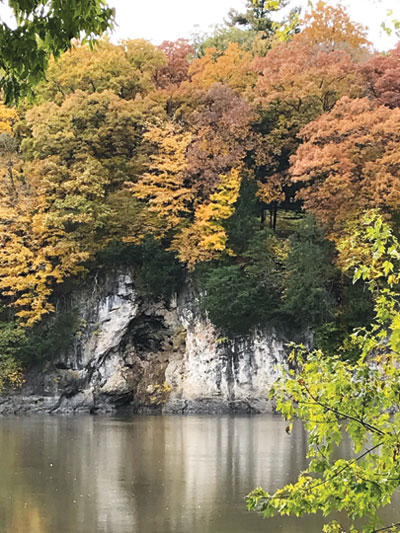
Just past the main entrance of the Cedar Cliff Trail, a jaw-dropping cave on the opposite bank forced me to stop and gawk a while. She stared right back at me, a great round eye in a wash of whitened stone streaked with dramatic black, like she’d been crying off her mascara for a thousand years.
I was making a nearby pair of geese nervous, so I moved on to see what else Mother Nature had made in these Palisades. The path rose up steep through the trees.
Soon the river was shimmering far, far below. The forest floor to my right was a carpet of gold and the asters were having one final purple hurrah before the first hard frost arrived in just two days’ time.
A couple houses and even farms dotted the woods across the river. What I wanted to know—as I paused for yet another photograph that could never do the view justice—was, “Who are the jerks (ahem, I mean blessed people) who get to live over there, and how do I make friends with them?” I sure would have liked to see the ledge I was standing on from across the water. I pondered if Carl Sandburg ever got to see this place from the other side. Apparently he was an annual visitor in the 1920s and ’30s.
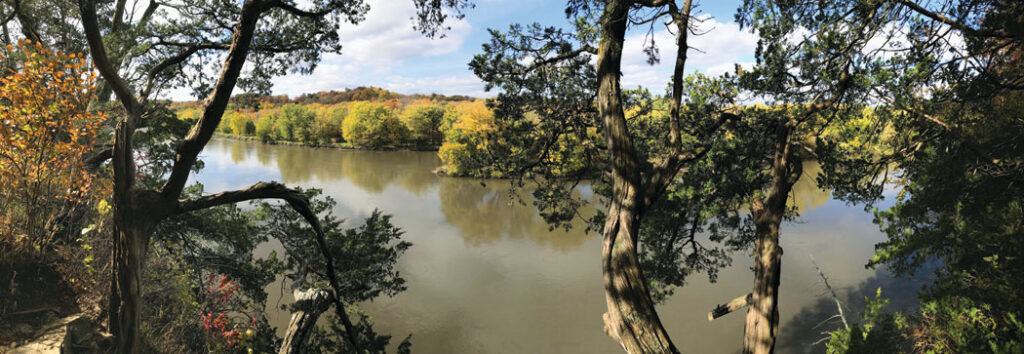
It’s not very often I feel I’ve got permission in a state park to go “off-roading” without breaking the rules, but the Palisades-Kepler park guide explicitly encourages visitors to wander and explore as they please. The cliffside trail curving west, then north, along the river’s edge offered the views I was after, so I didn’t get tooooo crazy. Just don’t tell my mother how far out I climbed on some rocks to get a pano shot of the river. I ate my lunch on that perch amidst the treetops, keeping very fine company with a Cedar Waxwing who also preferred a grand vista.
Later, I took advantage of a split-off trail that journeyed steeply down toward the water for a bluff view overhead instead of underfoot.
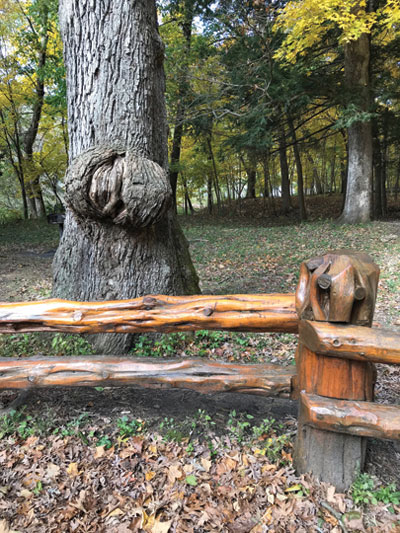
Between 1934 and 1941, a 200-man Civilian Conservation Core completed some impressive feats of craftsmanship 12 years after the State Board of Conservation established the park. The natural stone stairways and walkways, wooden fencing, benches, gazebos, bridges, and lodges were almost as impressive as the scenery. But in the end, they were no match for the master stonemason herself.
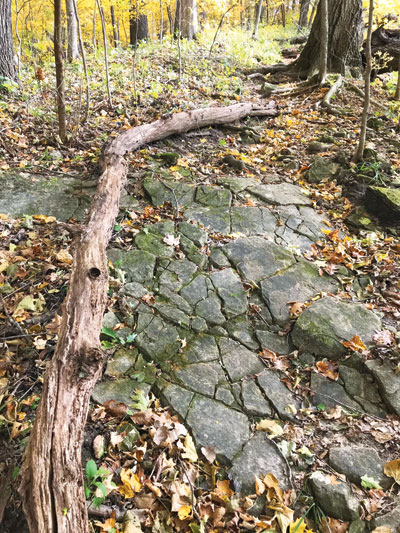
The area has been a treasured spot for hundreds of years, and among its many natural features, the park has also preserved the site of Indian burial mounds.
Just about the time I heard semis roaring by on 218, the trail petered out into a patch of poison ivy marking its end. I turned around. The great thing about this trail is you get to see everything twice. I think you’ll find that twice will not be enough.
Saving More Than Seeds
I didn’t arrive at Seed Savers Exchange (SSE) in Decorah last September expecting to find eight miles of trails—just a bevy of blooms and the last tomatoes of the season. But the pastoral charm of the path heading east from its Heritage Farm was a spontaneous hike I won’t forget. Perhaps, too, because it was my birthday.
After ogling the towering flowerbeds and veg gardens from which this nonprofit enterprise harvests vast varieties of heirloom seeds every year, my cup overfloweth as I set off down the lane in the late afternoon with my friend Margaux.
Across a pretty bridge marking the edge of the farm’s tidy lawn, the trail swung toward the tree line, meandering in and out of the sun for a while beside a lazy trout stream, another of the SSE’s conservation efforts. Margaux and I paused on a shady bench to take in the gurgling brook. Bees were abuzz, the dappled light flickered in my lap as I ate my apple, and I felt I’d come upon a little pocket of heaven. I could have stayed there for hours.
“Welcome to a little piece of paradise,” says the SSE website. Okay, now I get it, I thought. There on that bench, I was suddenly the heroine of a historical movie. Or the subject of a Carl Larsson painting. The only things missing were looped braids and a red striped apron.
Margaux and I mused at the wildflowers (one had fruit that resembled a baby watermelon with spikes!) as we continued down this most pleasant of paths. The trail was taking us toward a hilly meadow vista, its dramatic ups and downs typical of Iowa’s Driftless region. In the distance the sun illuminated an impressive herd of Ancient White Park cattle, another endangered breed this one-of-a-kind farm is helping to preserve. Just a few of the cattle had been brought over from the British Isles for safekeeping from the threat of Nazi invasion in the 1940s, their offspring moving from Toronto to New York, to Texas, and finally to Iowa.
As beautiful as they are, “from a distance” is how one should probably view White Park cattle. At several hundred yards away, we could still make out their exceedingly pointy horns.
The turkeys I made friends with at Heritage Farm, however, were the beasts that stole my heart that day. I have never come across such amazing birds. And with such personality. The male of the pair was a work of fine art, an absolute king. His face—a swirl of blues, reds, and purpley-greys—was surreal, and His Royal Majesty afforded me a good long look before making his way, in slow motion, back to the shade of the Heritage Poultry Barn. His mate was less than beautiful, her scrawny pink head was pathetic and bare, but oh my, her big bright eyes absolutely captivated me. She waddled right up close; I could have touched her if I’d wanted. She cocked her head, making inquisitive chirps as she observed me through the fence.
“Twirdle?” she asked.
“Why, yes.” I replied. She cooed and cooed as I answered all her questions. I had a hard time walking away from that bird. A turkey, of all things.
I opted for chicken come Thanksgiving, and I’ll be in a real pickle if I ever make friends with one of those.
Add a Seed Savers hike to a few other area gems and you’ve got yourself one fantastic day. Decorah, Iowa, is also home to the Vesterheim Norwegian-American Heritage Museum and, just a few blocks north of downtown, a huge natural waterfall in Dunnings Spring Park. Ahhhhh, water.
